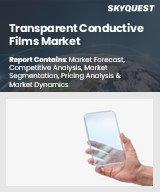
|
시장보고서
상품코드
1722946
세계의 투명 전도성 필름 시장 규모, 점유율, 동향, 예측 : 재료, 용도, 지역별(2025-2033년)Transparent Conductive Films Market Size, Share, Trends and Forecast by Material, Application, and Region, 2025-2033 |
||||||
투명 전도성 필름 세계 시장 규모는 2024년 67억 5,000만 달러에 달했습니다. 향후 IMARC Group은 이 시장이 2033년에는 116억 달러에 달하고, 2025-2033년 6.20%의 연평균 복합 성장률(CAGR)을 보일 것으로 예측했습니다. 현재 아시아태평양이 시장을 독점하고 있으며, 2024년 시장 점유율은 45.0% 이상에 달했습니다. 이는 주로 전자제품 제조 수요 증가와 스마트폰 생산의 급증에 기인합니다.
투명 전도성 필름(TCF)은 축퇴 도핑된 n형 반도체인 인듐-주석 산화물(ITO)을 사용한 박막입니다. 내열성, 내화학성이 우수하고 불소 도핑된 산화주석(FTO) 막에 비해 투과율이 높습니다. 광학적으로 투명성이 높고, 대면적에서 높은 전도성을 발휘합니다. 또한, TCF는 비용 효율이 높고, 커스터마이징이 가능하며, 다양한 금속을 선택하여 맞춤형 요구 사항을 충족시킬 수 있기 때문에 TCF는 전 세계 구부릴 수 있는 디스플레이, 플렉서블 디스플레이, 웨어러블 디스플레이에 광범위하게 적용되고 있습니다.
투명 전도성 필름 시장 동향 :
급속한 세계화, 가처분 소득 증가, 상시 연결에 대한 욕구 증가로 인해 스마트폰, 태블릿, PC, TV 등 가전제품의 채택이 전 세계적으로 증가하고 있습니다. TCF는 우수한 성능, 유연성, 내구성, 조절 가능한 투명성, 가공성, 안정성, 높은 전도성으로 인해 이러한 전자기기 제조에 널리 사용되고 있으며, 이는 시장 성장을 가속하는 중요한 요인 중 하나입니다. 또한, 키보드나 마우스와 같은 외부 장치를 사용하지 않고 메뉴 옵션을 빠르고 효율적으로 선택할 수 있고, 높은 내구성과 신뢰성을 제공할 수 있기 때문에 터치 사용자 인터페이스(UI)에 대한 선호도가 높아지고 있습니다. 이와 더불어, 핸드헬드 기기 및 터치 지원 액정표시장치(LCD) 패널에 터치 UI의 채택이 증가하고 있는 것도 시장 성장에 기여하고 있습니다. 또한, ITO를 사용한 TCF 층은 고가이며, 광학적인 투명성에도 한계가 있습니다. 그 결과, 주요 기업들은 차세대 TCF를 제조하기 위해 미세하게 인쇄된 전도성 메쉬, 투명도가 높은 은과 구리 층, 유기 투명 도체, 탄소나노튜브 및 그래핀과 같은 변종을 활용하고 있으며, 이는 좋은 시장 전망을 창출하고 있습니다.
본 보고서에서 다룬 주요 질문
- 투명 전도성 필름이란?
- 투명 전도성 필름 시장 규모는?
- 2025-2033년 투명 전도성 필름 세계 시장 성장률 전망은?
- 투명 전도성 필름 세계 시장을 주도하는 주요 요인은?
- 투명 전도성 필름 세계 시장에서 재료별 주요 부문은 무엇인가?
- 투명 전도성 필름 세계 시장 내 주요 응용 분야는 무엇인가?
- 투명 전도성 필름 세계 시장에서 주요 지역은?
- 투명 전도성 필름 세계 시장에서 주요 기업은?
목차
제1장 서문
제2장 조사 범위와 조사 방법
- 조사 목적
- 이해관계자
- 데이터 소스
- 1차 정보
- 2차 정보
- 시장 추정
- 보텀업 접근
- 톱다운 접근
- 조사 방법
제3장 주요 요약
제4장 서론
- 개요
- 주요 업계 동향
제5장 세계의 투명 전도성 필름 시장
- 시장 개요
- 시장 실적
- COVID-19의 영향
- 시장 예측
제6장 시장 분석 : 재료별
- 산화인듐주석(ITO) 유리 기판
- 산화인듐주석(ITO) PET 기판
- 은나노와이어
- 탄소나노튜브
- 전도성 폴리머
- 기타
제7장 시장 분석 : 용도별
- 스마트폰
- 노트북
- 태블릿
- PC
- 웨어러블 디바이스
- 기타
제8장 시장 분석 : 지역별
- 북미
- 미국
- 캐나다
- 아시아태평양
- 중국
- 일본
- 인도
- 한국
- 호주
- 인도네시아
- 기타
- 유럽
- 독일
- 프랑스
- 영국
- 이탈리아
- 스페인
- 러시아
- 기타
- 라틴아메리카
- 브라질
- 멕시코
- 기타
- 중동 및 아프리카
- 시장 내역 : 국가별
제9장 SWOT 분석
- 개요
- 강점
- 약점
- 기회
- 위협
제10장 밸류체인 분석
제11장 Porter의 Five Forces 분석
- 개요
- 바이어의 교섭력
- 공급 기업의 교섭력
- 경쟁 정도
- 신규 진출업체의 위협
- 대체품의 위협
제12장 가격 분석
제13장 경쟁 구도
- 시장 구조
- 주요 기업
- 주요 기업 개요
- C3Nano Inc.
- Cambrios Technologies Corporation
- Canatu Oy
- Dontech Inc
- DuPont de Nemours Inc.
- Eastman Kodak Company
- Gunze Limited
- Nitto Denko Corporation
- OIKE & Co. Ltd.
- TDK Corporation
- Toyobo Co. Ltd.
The global transparent conductive films market size was valued at USD 6.75 Billion in 2024. Looking forward, IMARC Group estimates the market to reach USD 11.60 Billion by 2033, exhibiting a CAGR of 6.20% from 2025-2033. Asia Pacific currently dominates the market, holding a market share of over 45.0% in 2024. This is mainly due to amplifying requirement from electronics manufacturing and proliferating smartphone production.
Transparent conductive films (TCFs) are thin layers made using indium tin oxide (ITO), which is a degenerately doped n-type semiconductor. They are highly resistant to heat and chemicals and offer superior transmittance compared to fluorine-doped tin oxide (FTO) films. They have high optical transparency and provide high electrical conductivity over larger areas. As they are also cost-effective, customizable, and work with a broad selection of metals to meet custom requirements, TCFs find extensive applications in bendable, flexible, and wearable displays across the globe.
Transparent Conductive Films Market Trends:
Due to rapid globalization, inflating disposable incomes and the increasing need to stay connected, there is an increase in the adoption of consumer electronics, such as smartphones, tablets, personal computers (PCs), and televisions, around the world. This represents one of the key factors bolstering the growth of the market. TCFs are widely utilized in the production of these electronics on account of their excellent performance, flexibility, durability, tunable transparency, processability, stability, and high conductivity. Additionally, there is a rise in the preference for touch user interface (UI) due to its ability to avoid external devices like keyboard and mouse, provide a quick and efficient selection of menu options, and offer high durability and reliability. This, along with the increasing adoption of touch UI in handheld devices and touch-enabled liquid crystal display (LCD) panels, is contributing to the market growth. Furthermore, TCF layers made using ITO are expensive and have limited optical transparency. As a result, leading players are utilizing finely printed conductive meshes, layers of silver or copper that are highly transparent, organic transparent conductors and variants, such as carbon nanotubes and graphene, to manufacture new generation TCFs, which is creating a favorable market outlook.
Key Market Segmentation:
Breakup by Material:
- Indium Tin Oxide (ITO) on Glass
- Indium Tin Oxide (ITO) on PET
- Silver Nanowire
- Carbon Nanotubes
- Conductive Polymers
- Others
Breakup by Application:
- Smart Phones
- Notebooks
- Tablet
- PC
- Wearable Devices
- Others
Breakup by Region:
- North America
- United States
- Canada
- Asia-Pacific
- China
- Japan
- India
- South Korea
- Australia
- Indonesia
- Others
- Europe
- Germany
- France
- United Kingdom
- Italy
- Spain
- Russia
- Others
- Latin America
- Brazil
- Mexico
- Others
- Middle East and Africa
Competitive Landscape:
The competitive landscape of the industry has also been examined along with the profiles of the key players being C3Nano Inc., Cambrios Technologies Corporation, Canatu Oy, Dontech Inc, DuPont de Nemours Inc., Eastman Kodak Company, Gunze Limited, Nitto Denko Corporation, OIKE & Co. Ltd., TDK Corporation and Toyobo Co. Ltd.
Key Questions Answered in This Report
- 1.What is transparent conductive films?
- 2.How big is the transparent conductive films market?
- 3.What is the expected growth rate of the global transparent conductive films market during 2025-2033?
- 4.What are the key factors driving the global transparent conductive films market?
- 5.What is the leading segment of the global transparent conductive films market based on material?
- 6.What is the leading segment of the global transparent conductive films market based on application?
- 7.What are the key regions in the global transparent conductive films market?
- 8.Who are the key players/companies in the global transparent conductive films market?
Table of Contents
1 Preface
2 Scope and Methodology
- 2.1 Objectives of the Study
- 2.2 Stakeholders
- 2.3 Data Sources
- 2.3.1 Primary Sources
- 2.3.2 Secondary Sources
- 2.4 Market Estimation
- 2.4.1 Bottom-Up Approach
- 2.4.2 Top-Down Approach
- 2.5 Forecasting Methodology
3 Executive Summary
4 Introduction
- 4.1 Overview
- 4.2 Key Industry Trends
5 Global Transparent Conductive Films Market
- 5.1 Market Overview
- 5.2 Market Performance
- 5.3 Impact of COVID-19
- 5.4 Market Forecast
6 Market Breakup by Material
- 6.1 Indium Tin Oxide (ITO) on Glass
- 6.1.1 Market Trends
- 6.1.2 Market Forecast
- 6.2 Indium Tin Oxide (ITO) on PET
- 6.2.1 Market Trends
- 6.2.2 Market Forecast
- 6.3 Silver Nanowire
- 6.3.1 Market Trends
- 6.3.2 Market Forecast
- 6.4 Carbon Nanotubes
- 6.4.1 Market Trends
- 6.4.2 Market Forecast
- 6.5 Conductive Polymers
- 6.5.1 Market Trends
- 6.5.2 Market Forecast
- 6.6 Others
- 6.6.1 Market Trends
- 6.6.2 Market Forecast
7 Market Breakup by Application
- 7.1 Smart Phones
- 7.1.1 Market Trends
- 7.1.2 Market Forecast
- 7.2 Notebooks
- 7.2.1 Market Trends
- 7.2.2 Market Forecast
- 7.3 Tablet
- 7.3.1 Market Trends
- 7.3.2 Market Forecast
- 7.4 PC
- 7.4.1 Market Trends
- 7.4.2 Market Forecast
- 7.5 Wearable Devices
- 7.5.1 Market Trends
- 7.5.2 Market Forecast
- 7.6 Others
- 7.6.1 Market Trends
- 7.6.2 Market Forecast
8 Market Breakup by Region
- 8.1 North America
- 8.1.1 United States
- 8.1.1.1 Market Trends
- 8.1.1.2 Market Forecast
- 8.1.2 Canada
- 8.1.2.1 Market Trends
- 8.1.2.2 Market Forecast
- 8.1.1 United States
- 8.2 Asia-Pacific
- 8.2.1 China
- 8.2.1.1 Market Trends
- 8.2.1.2 Market Forecast
- 8.2.2 Japan
- 8.2.2.1 Market Trends
- 8.2.2.2 Market Forecast
- 8.2.3 India
- 8.2.3.1 Market Trends
- 8.2.3.2 Market Forecast
- 8.2.4 South Korea
- 8.2.4.1 Market Trends
- 8.2.4.2 Market Forecast
- 8.2.5 Australia
- 8.2.5.1 Market Trends
- 8.2.5.2 Market Forecast
- 8.2.6 Indonesia
- 8.2.6.1 Market Trends
- 8.2.6.2 Market Forecast
- 8.2.7 Others
- 8.2.7.1 Market Trends
- 8.2.7.2 Market Forecast
- 8.2.1 China
- 8.3 Europe
- 8.3.1 Germany
- 8.3.1.1 Market Trends
- 8.3.1.2 Market Forecast
- 8.3.2 France
- 8.3.2.1 Market Trends
- 8.3.2.2 Market Forecast
- 8.3.3 United Kingdom
- 8.3.3.1 Market Trends
- 8.3.3.2 Market Forecast
- 8.3.4 Italy
- 8.3.4.1 Market Trends
- 8.3.4.2 Market Forecast
- 8.3.5 Spain
- 8.3.5.1 Market Trends
- 8.3.5.2 Market Forecast
- 8.3.6 Russia
- 8.3.6.1 Market Trends
- 8.3.6.2 Market Forecast
- 8.3.7 Others
- 8.3.7.1 Market Trends
- 8.3.7.2 Market Forecast
- 8.3.1 Germany
- 8.4 Latin America
- 8.4.1 Brazil
- 8.4.1.1 Market Trends
- 8.4.1.2 Market Forecast
- 8.4.2 Mexico
- 8.4.2.1 Market Trends
- 8.4.2.2 Market Forecast
- 8.4.3 Others
- 8.4.3.1 Market Trends
- 8.4.3.2 Market Forecast
- 8.4.1 Brazil
- 8.5 Middle East and Africa
- 8.5.1 Market Trends
- 8.5.2 Market Breakup by Country
- 8.5.3 Market Forecast
9 SWOT Analysis
- 9.1 Overview
- 9.2 Strengths
- 9.3 Weaknesses
- 9.4 Opportunities
- 9.5 Threats
10 Value Chain Analysis
11 Porters Five Forces Analysis
- 11.1 Overview
- 11.2 Bargaining Power of Buyers
- 11.3 Bargaining Power of Suppliers
- 11.4 Degree of Competition
- 11.5 Threat of New Entrants
- 11.6 Threat of Substitutes
12 Price Analysis
13 Competitive Landscape
- 13.1 Market Structure
- 13.2 Key Players
- 13.3 Profiles of Key Players
- 13.3.1 C3Nano Inc.
- 13.3.1.1 Company Overview
- 13.3.1.2 Product Portfolio
- 13.3.2 Cambrios Technologies Corporation
- 13.3.2.1 Company Overview
- 13.3.2.2 Product Portfolio
- 13.3.3 Canatu Oy
- 13.3.3.1 Company Overview
- 13.3.3.2 Product Portfolio
- 13.3.4 Dontech Inc
- 13.3.4.1 Company Overview
- 13.3.4.2 Product Portfolio
- 13.3.5 DuPont de Nemours Inc.
- 13.3.5.1 Company Overview
- 13.3.5.2 Product Portfolio
- 13.3.5.3 Financials
- 13.3.5.4 SWOT Analysis
- 13.3.6 Eastman Kodak Company
- 13.3.6.1 Company Overview
- 13.3.6.2 Product Portfolio
- 13.3.6.3 Financials
- 13.3.6.4 SWOT Analysis
- 13.3.7 Gunze Limited
- 13.3.7.1 Company Overview
- 13.3.7.2 Product Portfolio
- 13.3.7.3 Financials
- 13.3.8 Nitto Denko Corporation
- 13.3.8.1 Company Overview
- 13.3.8.2 Product Portfolio
- 13.3.8.3 Financials
- 13.3.8.4 SWOT Analysis
- 13.3.9 OIKE & Co. Ltd.
- 13.3.9.1 Company Overview
- 13.3.9.2 Product Portfolio
- 13.3.10 TDK Corporation
- 13.3.10.1 Company Overview
- 13.3.10.2 Product Portfolio
- 13.3.10.3 Financials
- 13.3.10.4 SWOT Analysis
- 13.3.11 Toyobo Co. Ltd.
- 13.3.11.1 Company Overview
- 13.3.11.2 Product Portfolio
- 13.3.11.3 Financials
- 13.3.11.4 SWOT Analysis
- 13.3.1 C3Nano Inc.



















